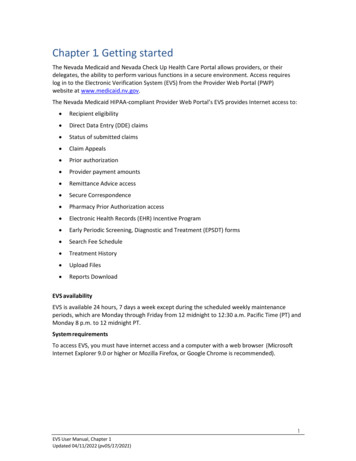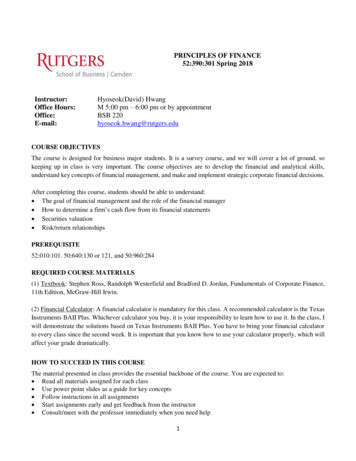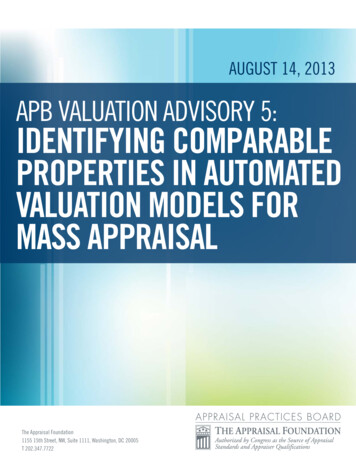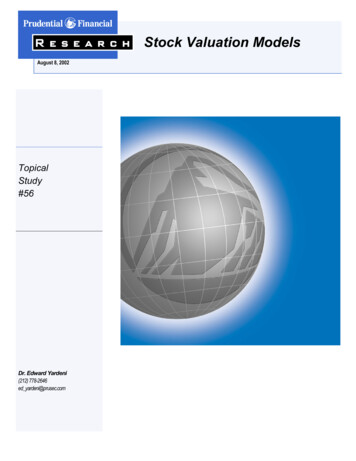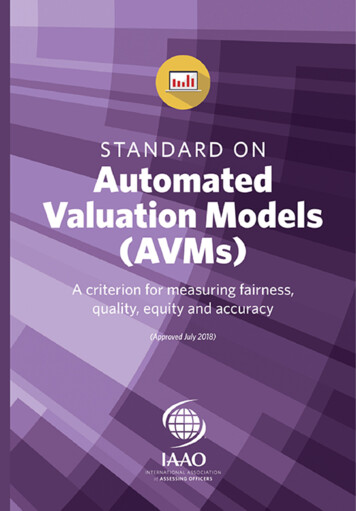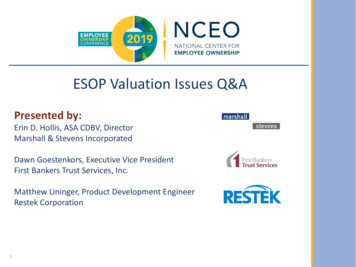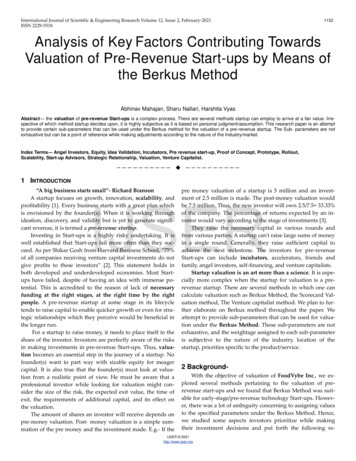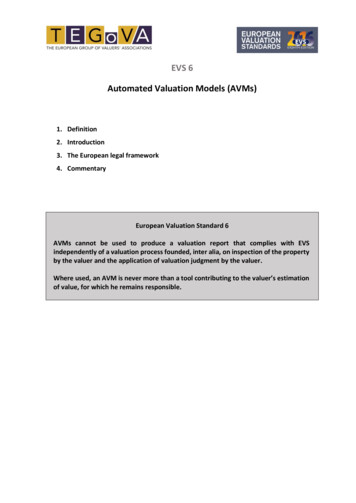
Transcription
EVS 6Automated Valuation Models (AVMs)1. Definition2. Introduction3. The European legal framework4. CommentaryEuropean Valuation Standard 6AVMs cannot be used to produce a valuation report that complies with EVSindependently of a valuation process founded, inter alia, on inspection of the propertyby the valuer and the application of valuation judgment by the valuer.Where used, an AVM is never more than a tool contributing to the valuer’s estimationof value, for which he remains responsible.
1. Definition1.1 AVMs are statistically-based computer programmes which use property information togenerate property-related values or suggested values.1.2 A statistical method of valuation seeks to arrive at the value of a property directly throughthe application of a mathematical algorithm to a data base of transaction prices and propertycharacteristics whilst omitting:i) an explicit traditional valuation, such as a comparative or income based approach valuationandii) a professional valuer's qualitative assessment of the value.Hence, in the context of real estate valuation, an AVM is simply the mechanical application ofan algorithmic procedure to the data presented to it, without taking into account a valuer’sopinion as to other relevant information, without a physical inspection of the property andignoring the weighting a valuer would place on the relevant information.1.3 An AVM is not a valuation. It can serve as a starting point for some buyers and sellers inconsidering a property’s value. It can be used by the qualified valuer as one input in hiscomprehensive analysis of the market provided he is satisfied with his knowledge of the AVM’sinput data and model (see EVGN 11 “The Valuer’s Use of Statistical Tools”).2. Introduction2.1 Used as a tool for valuing properties quickly and at low cost, AVMs have intrinsiclimitations: They can only work from the figures for the transactions reported without informationor insight into their contextThere is no inspection of the property. They must rely on an implicit assumption thatthe property is in marketable conditionA limited ability to account for external influencesLimited coverage of relevant data in some areasLimited coverage of relevant recent data for some propertiesA limited ability to reflect any unique characteristics of the propertyThey are unlikely to be relevant for specialist propertiesThere is little hard impartial evidence in the public domain or independent evaluation of theaccuracy of AVMs for individual properties as European AVM manufacturers are reluctant to2
release details and the underlying data or the construction of the algorithms are not madeavailable for analysis.12.2 Those limitations have less potential negative consequences concerning the standard usesof AVMs in considering properties collectively, as for: Banks identifying property that needs revaluationIn-arrears assessment in banksIdentification of fraudulent activity in banksFull valuation audits in banksDetermining capital adequacy ratios in banksMark-to-Market portfolio of properties in banksMass Appraisal for local taxes by governmentEstimating relocation compensation by governmentCost/Benefit analysis for potential public expenditure2.3 In recent years, AVMs have become much more widespread as a result of a drive towardsrationalisation in the property and financial sector. Abusive use of AVMs was one of thereasons for the financial crisis, as was stated in the final report of the parliamentary committeeof inquiry of 27 January 2016 regarding the Irish banking crisis2:“More widely, however, the demand for asset valuations increased significantly as theproperty boom took hold and reliance on informal valuation standards, such as ‘desktop’and ‘drive-by’ valuations, became more prevalent. These did not involve any physicalinspection of the property, but were a limited (and sometimes fully automated orcomputer generated) process of estimating value. A Central Bank review of financialinstitutions found that many used these informal valuations as if they were formalvaluations. [74 – Central Bank Report, Valuation Processes in the Banking Crisis – LessonsLearned – Guiding the Future, 18 December 2012, PUB00252-008] A number ofdevelopers gave evidence that they continued to rely on professional valuations.Valuations exert significant impact on a financial institution’s credit risk management. Asmitigation against risk, it is imperative that the valuation process is robust and that thevalue attributed to the underlying assets can be relied upon when fully assessing the riskof a credit decision or the ongoing management of the loan. For that reason a reliablevaluation document is central to the credit risk decision. [75 – Central Bank Report,Valuation Processes in the Banking Crisis – Lessons Learned – Guiding the Future, 18December 2012, PUB00252-016]”2.4 As they can only work by projecting forward from past data, they are likely to be procyclical in effect at points where the relevant market is b2c3 Geoge Matysiak Valuation lume1.pdf.3
2.5 These intrinsic drawbacks and their contribution to the financial crisis inspired therestrictions on use of AVMs laid down by the EU legislator.3. The European legal framework3.1 The effect of Article 19 of the Mortgage Credit Directive and Article 229(1) of the CapitalRequirements Regulation is that AVMs cannot be used to provide property valuationsindependently of professionally competent internal and external valuers. The opinions andguidelines of the European Banking Authority (EBA) and the Financial Stability Board (FSB) bothmirror and justify this requirement.3.1.1 The Mortgage Credit Directive3.1.1.1 The Mortgage Credit Directive has a primary emphasis on consumer protection forborrowers coupled with the aim to guarantee financial market stability.3.1.1.2 The Mortgage Credit Directive does not address AVMs as such. The limitations on theiruse follow from the Directive’s insistence on the use of reliable valuation standards by“professionally competent internal and external appraisers” (Article 19).3.1.2 The Capital Requirements Regulation3.1.2.1 The Capital Requirements Regulation constitutes, together with the CapitalRequirements Directive, the legal framework governing the access to the activity, thesupervisory framework and the prudential rules for credit institutions and investment firms.3.1.2.2 In order to strengthen the financial system and ensure a level playing field within theinternal market, the CRR ensures a maximum harmonisation of credit institutions’ prudentialrequirements. In this context, the CRR is very clear that property valuation needs to be doneby a qualified valuer:“Institutions may use statistical methods to monitor the value of the property and toidentify property that needs revaluation.” CRR Article 208(3), last sentence3.1.2.3 According to that provision, the application of statistical methods (including the use ofAVMs) can only be engaged to monitor the value of the property and to identify property thatneeds revaluation. The use of such methods is not allowed for the actual valuation of theimmovable property. This applies a fortiori to the original or first-time valuations where novalue has yet been established and can be monitored.4
3.1.3 The “good practices” issued by the European Banking Authority3.1.3.1 Issued on 1 July 2015 in response to the Mortgage Credit Directive3, the EBA’s goodpractices underline that it is very important to determine the correct value of the immovableproperty when using or establishing the loan-to-value ratio. According to the EBA, this value isto be determined on the basis of “a robust and prudent approach to property appraisals”:“Good practice 10: Where national frameworks specify controls, standards or incentiveson LTV (loan-to-value) ratios, it is good practice to ensure that creditors satisfythemselves that the LTV ratio takes into consideration the ‘real value’ of the availableequity, which could be calculated on the basis of (i) a robust and prudent approach toproperty appraisals [10 – The prudential interest in a robust approach to collateralmanagement is addressed in detail in FSB Principle 4]; .”3.1.3.2 The EBA’s opinion as regards the robust and prudent property valuation explicitlyrefers to the Principles on Sound Residential Mortgage Underwriting Practices issued by theFSB in 20124. Part 4 of these principles gives additional guidance on how the risks inherentlyassociated to collateral management can be controlled or avoided:“4.1 Jurisdictions should ensure that lenders adopt and adhere to adequate internalrisk management and collateral management processes, which include soundappraisal processes. Proper collateral management should include onsite inspections bylenders or appraisers; but onsite inspections could be exempted if the lender or appraiseris able to demonstrate that the risk posed has been adequately assessed through theoverall collateral management process.For example, a flat or an apartment in a multi-family building which had recentlyundergone an on-site inspection could be exempted.”4. Commentary4.1 “AVMs cannot be used to produce a valuation report that complies with EVSindependently of a valuation process founded, inter alia, on inspection of the property bythe valuer and the application of valuation judgment by the valuer.Where used, an AVM is never more than a tool contributing to the valuer’s estimation ofvalue, for which he remains responsible.”4.1.1 The use of AVMs otherwise than as support for a qualified valuer undertaking avaluation report is excluded for the actual valuation of an individual immovable 0/983359/EBA-Op-2015-09 Opinion on good practices for ds/r 120418.pdf?page moved 1.5
4.1.2 This applies a fortiori to the original or first-time valuation where no value has yet beenestablished and can be monitored.4.1.3 This is a consequence of the fact that the prime concern in the valuation of anindividual property is the accuracy that those relying on it need to conduct their businesswith confidence, whether as the buyer, owner or other party, or mortgage debtor, not thebank. Protection of the individual consumer requires a valuation report by a qualified valuerto ensure maximum accuracy concerning what is often the most important transaction in aperson’s existence.4.1.4 Where used, an AVM figure must never be more than one element of the panoply ofinputs that the valuer uses and reconciles in reaching his estimation of value. However, evenas one comparative element or benchmark, use of the AVM requires that the valuer be awareof and satisfied with the AVM’s input data (for instance sales prices as opposed to askingprices) and how they are used, in making a sound professional judgment of the degree ofproficiency and reliability underlying the AVM calculation.4.2. AVMs may be used without inspection of the property in the cases of banks monitoringthe values of their property portfolios or identifying property that needs revaluation.4.2.1. Banks (and owners of large real estate portfolios) review vast numbers of propertiesconstituting their real estate collateral. It is part of their obligations under EU bankingsupervision legislation and under the Asset Quality Review of the ECB. As to the deploymentof statistical techniques, these measures serve to ascertain the solvency of banks and can thussafely be based on averages for which the output from AVMs may often be relevant. This usehas no consequences for mortgage debtors in terms of the value of their individual propertiesserving as collateral.6
6 4.1.2 This applies a fortiori to the original or first-time valuation where no value has yet been established and can be monitored. 4.1.3 This is a consequence of the fact that the prime concern in the valuation of an individual property is the accuracy that those relying on it need to conduct their business with confidence, whether as the buyer, owner or other party, or mortgage debtor, not the
